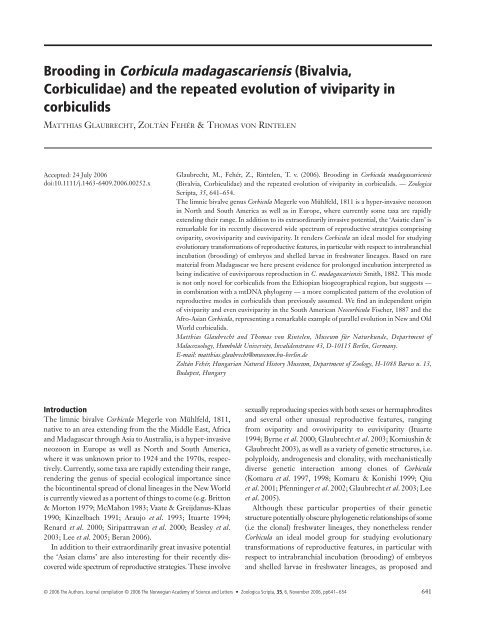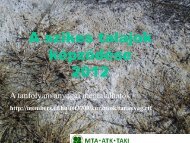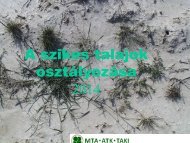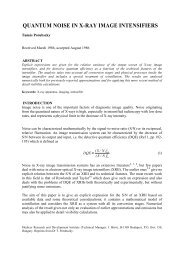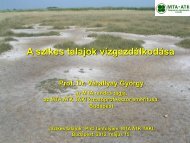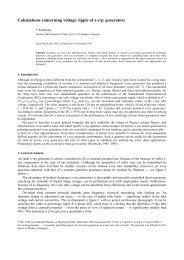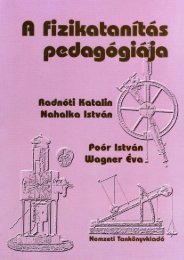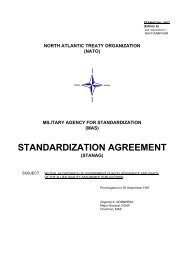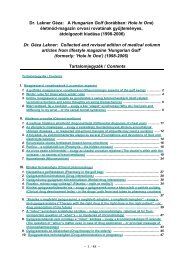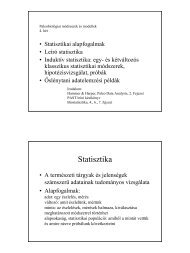Brooding in Corbicula madagascariensis (Bivalvia, Corbiculidae)
Brooding in Corbicula madagascariensis (Bivalvia, Corbiculidae)
Brooding in Corbicula madagascariensis (Bivalvia, Corbiculidae)
- No tags were found...
Create successful ePaper yourself
Turn your PDF publications into a flip-book with our unique Google optimized e-Paper software.
Blackwell Publish<strong>in</strong>g Ltd<strong>Brood<strong>in</strong>g</strong> <strong>in</strong> <strong>Corbicula</strong> <strong>madagascariensis</strong> (<strong>Bivalvia</strong>,<strong>Corbiculidae</strong>) and the repeated evolution of viviparity <strong>in</strong>corbiculidsMATTHIAS GLAUBRECHT, ZOLTÁN FEHÉR & THOMAS VON RINTELENAccepted: 24 July 2006doi:10.1111/j.1463-6409.2006.00252.xGlaubrecht, M., Fehér, Z., R<strong>in</strong>telen, T. v. (2006). <strong>Brood<strong>in</strong>g</strong> <strong>in</strong> <strong>Corbicula</strong> <strong>madagascariensis</strong>(<strong>Bivalvia</strong>, <strong>Corbiculidae</strong>) and the repeated evolution of viviparity <strong>in</strong> corbiculids. — ZoologicaScripta, 35, 641–654.The limnic bivalve genus <strong>Corbicula</strong> Megerle von Mühlfeld, 1811 is a hyper-<strong>in</strong>vasive neozoon<strong>in</strong> North and South America as well as <strong>in</strong> Europe, where currently some taxa are rapidlyextend<strong>in</strong>g their range. In addition to its extraord<strong>in</strong>arily <strong>in</strong>vasive potential, the ‘Asiatic clam’ isremarkable for its recently discovered wide spectrum of reproductive strategies compris<strong>in</strong>goviparity, ovoviviparity and euviviparity. It renders <strong>Corbicula</strong> an ideal model for study<strong>in</strong>gevolutionary transformations of reproductive features, <strong>in</strong> particular with respect to <strong>in</strong>trabranchial<strong>in</strong>cubation (brood<strong>in</strong>g) of embryos and shelled larvae <strong>in</strong> freshwater l<strong>in</strong>eages. Based on rarematerial from Madagascar we here present evidence for prolonged <strong>in</strong>cubation <strong>in</strong>terpreted asbe<strong>in</strong>g <strong>in</strong>dicative of euviviparous reproduction <strong>in</strong> C. <strong>madagascariensis</strong> Smith, 1882. This modeis not only novel for corbiculids from the Ethiopian biogeographical region, but suggests —<strong>in</strong> comb<strong>in</strong>ation with a mtDNA phylogeny — a more complicated pattern of the evolution ofreproductive modes <strong>in</strong> corbiculids than previously assumed. We f<strong>in</strong>d an <strong>in</strong>dependent orig<strong>in</strong>of viviparity and even euviviparity <strong>in</strong> the South American Neocorbicula Fischer, 1887 and theAfro-Asian <strong>Corbicula</strong>, represent<strong>in</strong>g a remarkable example of parallel evolution <strong>in</strong> New and OldWorld corbiculids.Matthias Glaubrecht and Thomas von R<strong>in</strong>telen, Museum für Naturkunde, Department ofMalacozoology, Humboldt University, Invalidenstrasse 43, D-10115 Berl<strong>in</strong>, Germany.E-mail: matthias.glaubrecht@museum.hu-berl<strong>in</strong>.deZoltán Fehér, Hungarian Natural History Museum, Department of Zoology, H-1088 Baross u. 13,Budapest, HungaryIntroductionThe limnic bivalve <strong>Corbicula</strong> Megerle von Mühlfeld, 1811,native to an area extend<strong>in</strong>g from the the Middle East, Africaand Madagascar through Asia to Australia, is a hyper-<strong>in</strong>vasiveneozoon <strong>in</strong> Europe as well as North and South America,where it was unknown prior to 1924 and the 1970s, respectively.Currently, some taxa are rapidly extend<strong>in</strong>g their range,render<strong>in</strong>g the genus of special ecological importance s<strong>in</strong>cethe bicont<strong>in</strong>ental spread of clonal l<strong>in</strong>eages <strong>in</strong> the New Worldis currently viewed as a portent of th<strong>in</strong>gs to come (e.g. Britton& Morton 1979; McMahon 1983; Vaate & Greijdanus-Klaas1990; K<strong>in</strong>zelbach 1991; Araujo et al. 1993; Ituarte 1994;Renard et al. 2000; Siripattrawan et al. 2000; Beasley et al.2003; Lee et al. 2005; Beran 2006).In addition to their extraord<strong>in</strong>arily great <strong>in</strong>vasive potentialthe ‘Asian clams’ are also <strong>in</strong>terest<strong>in</strong>g for their recently discoveredwide spectrum of reproductive strategies. These <strong>in</strong>volvesexually reproduc<strong>in</strong>g species with both sexes or hermaphroditesand several other unusual reproductive features, rang<strong>in</strong>gfrom oviparity and ovoviviparity to euviviparity (Ituarte1994; Byrne et al. 2000; Glaubrecht et al. 2003; Korniush<strong>in</strong> &Glaubrecht 2003), as well as a variety of genetic structures, i.e.polyploidy, androgenesis and clonality, with mechanisticallydiverse genetic <strong>in</strong>teraction among clones of <strong>Corbicula</strong>(Komaru et al. 1997, 1998; Komaru & Konishi 1999; Qiuet al. 2001; Pfenn<strong>in</strong>ger et al. 2002; Glaubrecht et al. 2003; Leeet al. 2005).Although these particular properties of their geneticstructure potentially obscure phylogenetic relationships of some(i.e the clonal) freshwater l<strong>in</strong>eages, they nonetheless render<strong>Corbicula</strong> an ideal model group for study<strong>in</strong>g evolutionarytransformations of reproductive features, <strong>in</strong> particular withrespect to <strong>in</strong>trabranchial <strong>in</strong>cubation (brood<strong>in</strong>g) of embryosand shelled larvae <strong>in</strong> freshwater l<strong>in</strong>eages, as proposed and© 2006 The Authors. Journal compilation © 2006 The Norwegian Academy of Science and Letters • Zoologica Scripta, 35, 6, November 2006, pp641–654 641
<strong>Brood<strong>in</strong>g</strong> <strong>in</strong> <strong>Corbiculidae</strong> • M. Glaubrecht et al.shown by Glaubrecht et al. (2003) and Korniush<strong>in</strong> &Glaubrecht (2003). For many years only the South AmericanNeocorbicula Fischer, 1887 was known to be euviviparous(Ituarte 1994). Recent studies of Southeast Asian taxa (<strong>in</strong> particularfrom the Indonesian island of Sulawesi) have revealednovel reproductive modes <strong>in</strong> <strong>Corbicula</strong>, h<strong>in</strong>t<strong>in</strong>g at euviviparityhav<strong>in</strong>g developed <strong>in</strong>dependently among differentl<strong>in</strong>eages of corbiculids (Korniush<strong>in</strong> & Glaubrecht 2003).This is further supported by f<strong>in</strong>d<strong>in</strong>gs reported here.Currently, African corbiculids are ma<strong>in</strong>ly subsumed undertwo species-level taxa, viz. C. flum<strong>in</strong>alis (Müller, 1774) andC. astart<strong>in</strong>a Martens, 1860, compris<strong>in</strong>g — particularly <strong>in</strong> thecase of the former — a plethora of subspecific differentiations.A third species, C. <strong>madagascariensis</strong> Smith, 1882, occurs onMadagascar (Mandahl-Barth 1988; Daget 1998; Korniush<strong>in</strong>2004). However, the systematics of corbiculids has not beenresolved satisfactorily, s<strong>in</strong>ce morphological charactersalone have proved to be equivocal (e.g. Glaubrecht et al.2006). The state of corbiculid taxonomy may be taken asanother prime example of the general dissent <strong>in</strong> the del<strong>in</strong>eationof species (for a review of this unresolved ‘species problem’ <strong>in</strong>malacology see e.g. Glaubrecht 2004). For example, for Asiancorbiculids the ‘splitters’ have dist<strong>in</strong>guished several taxa,with, for example, Prashad (1924, 1929, 1930) list<strong>in</strong>g up to70 species and Brandt (1974) list<strong>in</strong>g 26 species for Thailandalone (of which 20 proved to be synonyms of C. flum<strong>in</strong>eabased on allozyme studies; Kijviriya et al. 1991). For Indonesiasee Djajasamita (1975, 1977). In contrast, ‘lumpers’ acceptonly two conchologically highly variable, polymorphic taxa(e.g. Morton 1979, 1986).This confusion <strong>in</strong> species identity and taxonomy <strong>in</strong>corbiculids becomes evident from the comparison of, forexample, Mandahl-Barth (1988) and Daget (1998) for Africa,Morton (1986) and Harada & Nish<strong>in</strong>o (1995) for Japan,Brandt (1974) and Woodruff et al. (1993) for Thailand, orDjajasamita (1975, 1977) and Glaubrecht et al. (2003) forIndonesian and particularly Sulawesi taxa. For the particularcase of the cement<strong>in</strong>g (i.e. sessil) corbiculid named ‘Posostrea’from Lake Poso <strong>in</strong> Sulawesi, compare Bogan & Bouchet(1998) and R<strong>in</strong>telen & Glaubrecht (2006). Accord<strong>in</strong>gly, theconfus<strong>in</strong>g taxonomy and unresolved systematics of <strong>Corbicula</strong>have long hampered both fundamental and applied studies onthese important limnic bivalves.Recently, a number of studies based on mitochondrialsequence analyses have attempted to provide an at leastprelim<strong>in</strong>ary <strong>in</strong>sight <strong>in</strong>to the phylogenetic relationships ofcorbiculids. Siripattrawan et al. (2000) and Park & Kim(2003) both found the New World corbiculids Polymesoda andNeocorbicula to be basal to all other corbiculids, with theestuar<strong>in</strong>e (i.e. brackish-water) C. japonica Prime, 1864 fromEast Asia and the freshwater C. <strong>madagascariensis</strong> <strong>in</strong> basalposition to all other taxa with<strong>in</strong> <strong>Corbicula</strong>. The latter wasutilized as an outgoup <strong>in</strong> the study by Lee et al. (2005), whichhad a more restricted focus on <strong>in</strong>vasive populations <strong>in</strong> theNew World. A common feature of all phylogenies availableso far is that the exam<strong>in</strong>ed Asian, European and American<strong>Corbicula</strong> morphotypes form a cluster with poorly resolvedrelationships, with morphological and molecular characterssometimes <strong>in</strong> contradiction (e.g. Siripattrawan et al. 2000;Pfenn<strong>in</strong>ger et al. 2002; Glaubrecht et al. 2003; Park & Kim2003; Lee et al. 2005; R<strong>in</strong>telen & Glaubrecht 2006).<strong>Corbicula</strong> japonica has received relatively more attention(Miyazaki 1936; Maru 1981; Harada & Nish<strong>in</strong>o 1995) andecological as well as reproductive biological features seem tosupport its genetic dist<strong>in</strong>ctness, among them its brackish-waterhabitat, oviparity and monoflagellate haploid spermatozoa(Park & Kim 2003; Korniush<strong>in</strong> 2004). In contrast, due to thescarcity of available material from Madagascar, the reproductivebiology of C. <strong>madagascariensis</strong> rema<strong>in</strong>s unknown.Study<strong>in</strong>g the corbiculid type material <strong>in</strong> the Molluscacollection of the Natural History Museum of the HumboldtUniversity <strong>in</strong> Berl<strong>in</strong> (formerly Zoological Museum Berl<strong>in</strong>,ZMB) <strong>in</strong> the course of revisionary work on this family (seedetails <strong>in</strong> Glaubrecht et al. 2006), evidence for an euviviparousmode <strong>in</strong> C. <strong>madagascariensis</strong> was found upon closer <strong>in</strong>spectionof one group of specimens from Madagascar, as describedbelow. This is not only novel for corbiculids from the Ethiopianbiogeographical region, but it sets this taxon apart fromother oviparous and ovoviviparous taxa, <strong>in</strong> particular allknown morphotypes of C. flum<strong>in</strong>alis (Müller, 1774), africana(Krauss, 1848) and flum<strong>in</strong>ea (Müller, 1774), as del<strong>in</strong>eatedrecently by Korniush<strong>in</strong> (2004). F<strong>in</strong>ally, based on a revised andimproved molecular phylogeny us<strong>in</strong>g mitochondrial genesequence data for <strong>Corbiculidae</strong>, we discuss the evolution ofdist<strong>in</strong>ct reproductive modes <strong>in</strong> these bivalves, suggest<strong>in</strong>g the<strong>in</strong>dependent orig<strong>in</strong> of euviviparity and, presumably,matrotrophy.Materials and methodsThe Mollusca collection of the Natural History Museum ofthe Humboldt University <strong>in</strong> Berl<strong>in</strong> holds one lot of specimensof C. <strong>madagascariensis</strong> Smith, 1882 from Madagascar(ZMB Moll. 45.446), with one desiccated animal preservedwith<strong>in</strong> the closed valves of one of the two extant specimens.The sample, with the orig<strong>in</strong>al label ‘ZMB Moll. 45446:Zwei Schalen von <strong>Corbicula</strong> sikorae Ancey n. sp.; Madagascar,Annanarivo, F. Sikora’, was orig<strong>in</strong>ally identified as <strong>Corbicula</strong>sikorae Ancey, 1890. This species name is treated as a juniorsynonym of C. <strong>madagascariensis</strong> <strong>in</strong> the most recent catalogueof African bivalves (Daget 1998).The molecular phylogeny is based on a c. 710 bp genefragment of the mitochondrial cytochrome oxidase subunit I(COI) gene, which has proven suitable for this approach <strong>in</strong>earlier studies by the present and other authors. This gene642 Zoologica Scripta, 35, 6, November 2006, pp641–654 • © 2006 The Authors. Journal compilation © 2006 The Norwegian Academy of Science and Letters
M. Glaubrecht et al. • <strong>Brood<strong>in</strong>g</strong> <strong>in</strong> <strong>Corbiculidae</strong>was also chosen because a large number of corbiculid COIsequences is already accessible <strong>in</strong> GenBank and laboratorymethods are well established; <strong>in</strong> contrast, the same comprehensivedata set for nuclear genes for <strong>Corbiculidae</strong> is miss<strong>in</strong>g.In addition to two sequences of Batissa violacea fromSulawesi (see Table 1), published sequences (Siripattrawanet al. 2000; Glaubrecht et al. 2003; R<strong>in</strong>telen & Glaubrecht2006) were taken from GenBank. Laboratory protocols asdescribed by R<strong>in</strong>telen & Glaubrecht (2006), and universalprimers (LCO1490 and HCO2198; Folmer et al. 1994) wereused. Rungia cuneata and Mercenaria mercenaria were chosenas outgroups follow<strong>in</strong>g Park & Kim (2003).For the phylogenetic analysis we used the COI sequence ofC. <strong>madagascariensis</strong> for a specimen (UMMZ 255293) fromMadagascar, first published by Siripattrawan et al. (2000) anddeposited <strong>in</strong> GenBank as AF 196275 (see Table 1). It shouldbe noted that there was some confusion regard<strong>in</strong>g the speciesidentity of this taxon, s<strong>in</strong>ce different names are <strong>in</strong> use formtDNA sequence data (COI and 16S) deposited withGenBank. Recently Korniush<strong>in</strong> (2004) has argued and discussed<strong>in</strong> detail that the so-called ‘C. africana’ (Krauss, 1848) of somemolecular analyses (Pfenn<strong>in</strong>ger et al. 2002) actually representsC. <strong>madagascariensis</strong> from Madagascar, as correctly assignedby Siripattrawan et al. (2000). While the former should beconsidered a synonym (see Glaubrecht et al. 2006), the latteris accepted as represent<strong>in</strong>g a dist<strong>in</strong>ct species (see e.g. Daget1998; Korniush<strong>in</strong> 2004). Thus, we regard this sequence froman animal orig<strong>in</strong>at<strong>in</strong>g from Madagascar used here to berepresentative of this taxon.The sequence alignment of 614 bp was created by eye withBioEdit 5.09 (Hall 1999). The phylogeny was produced us<strong>in</strong>gthree methods: maximum parsimony (MP) with PAUP4.0b010 (Swofford 2003), maximum likelihood (ML) withTreef<strong>in</strong>der (Jobb 2005) and Bayesian <strong>in</strong>ference (BI) withMrBayes 3.1 (Ronquist & Huelsenbeck 2003). The MPanalysis was done us<strong>in</strong>g a full heuristic search with randomaddition (10 replicates) and TBR, while the simple additionoption and TBR were used <strong>in</strong> a MP bootstrap analysis (100replicates). For the ML and BI analyses an appropriate modelof sequence evolution was selected us<strong>in</strong>g MrModeltest2.2 (Nylander 2004); based on the Aikaike InformationCriterion, the GTR + I + Γ model was employed. The MLanalysis was done with the Treef<strong>in</strong>der default sett<strong>in</strong>gs,and 1000 RELL bootstrap replicates. For the BI analysisposterior probabilities of phylogenetic trees were estimatedby a 2 000 000 generation Metropolis-coupled MarkovCha<strong>in</strong> Monte Carlo algorithm (four cha<strong>in</strong>s, cha<strong>in</strong> temperature= 0.2), with parameters estimated from the data set. A 50%majority-rule consensus tree was constructed follow<strong>in</strong>ga 15 001 trees burn-<strong>in</strong> to allow likelihood values to reachstationarity. Modes of reproduction were reconstructed onthe tree us<strong>in</strong>g MacClade 4.08 (Maddison & Maddison 2005).Morphological voucher material of all corbiculids studiedhere<strong>in</strong> is deposited with the malacological collection ofZMB, if not stated otherwise (Table 1); all molecularsequences given <strong>in</strong> Table 1 with their respective accessionand collection numbers are available from GenBank.ResultsOn the species identityConchological exam<strong>in</strong>ation of the two specimens (ZMB45.446) and comparision with Ancey’s (1890) and Smith’s(1882) orig<strong>in</strong>al descriptions support the proposed synonymizationof <strong>Corbicula</strong> sikorae Ancey, 1890 with C. <strong>madagascariensis</strong>Smith, 1882.Accord<strong>in</strong>g to the <strong>in</strong>ventory record <strong>in</strong> ZMB, this lot wasbought directly from the Austrian collector Franz Sikora(?−1902), who was based <strong>in</strong> Réunion. For seven years he alsocollected specimens <strong>in</strong> Madagascar for various Europeanmuseums. The specimens of C. <strong>madagascariensis</strong> <strong>in</strong> questionwere <strong>in</strong>ventoried <strong>in</strong> ZMB <strong>in</strong> 1892. The material came fromthe type locality, given as ‘Fleuve Mangoro, dans l’<strong>in</strong>térieur deMadagascar, de Tananarive à la côte orientale, à une altitudede 700 mètres au-dessus du niveau de la mer (Sikora)’ (Ancey1890: 345), with ‘Annanarivo’ an apparent misspell<strong>in</strong>g ofAntananarivo (French: Tananarive), which is near the typelocality of Smith’s C. <strong>madagascariensis</strong> (cf. Smith 1882: 388).The whereabouts of Ancey’s type material is unknown(Daget 1998; Counts 1991). However, s<strong>in</strong>ce we have nofurther <strong>in</strong>formation relat<strong>in</strong>g to any potential relationshipbetween Ancey, Sikora and the then curator of ZMB, Eduardvon Martens (1832–1904), we refra<strong>in</strong> from assum<strong>in</strong>g thatthis material actually represents types. Moreover, the sizeparameters given <strong>in</strong> Ancey’s orig<strong>in</strong>al description (L: 11.5, H:8.5, W: 5 mm) do not correspond with those of either of thetwo ZMB specimens. Instead, we regard the ZMB material asrepresent<strong>in</strong>g topotypical material collected by Sikora, togetherwith Ancey’s later type material. It should be noted, however,that if Ancey’s types are lost, as appears to be the case, the ZMBmaterial qualifies for the designation as neotypes.Description of maternal animal and juvenilesZMB 45.446 comprises two adult specimens with orig<strong>in</strong>allyclosed valves with the follow<strong>in</strong>g size measurements for thelarger and smaller specimens, respectively: L: 15.5 and12.9 mm, H: 12.1 and 9.8 mm, W: 6.9 and 5.8 mm. Most ofthe conchological features (e.g. shell shape and sculpture) areperfectly <strong>in</strong> accord with the orig<strong>in</strong>al descriptions, except thatthe colour of the <strong>in</strong>ner valves is blueish-white <strong>in</strong> sikoraeaccord<strong>in</strong>g to Ancey, while that of <strong>madagascariensis</strong> is, accord<strong>in</strong>gto Smith’s orig<strong>in</strong>al description, ‘lilac with two or three ratherdistant concentric purple zones, sta<strong>in</strong>ed with dark purpledown the posterior side, and with smaller sta<strong>in</strong> of the samecolour at the anterior side’. The ZMB specimens, which© 2006 The Authors. Journal compilation © 2006 The Norwegian Academy of Science and Letters • Zoologica Scripta, 35, 6, November 2006, pp641–654 643
<strong>Brood<strong>in</strong>g</strong> <strong>in</strong> <strong>Corbiculidae</strong> • M. Glaubrecht et al.Table 1 Sample and sequence provenance, GenBank accession numbers, and museum accession numbers for ZMB samples of <strong>Corbiculidae</strong>.Accession numbersTaxonLocality dataMuseumGenBankReferenceMercenaria mercenaria (L<strong>in</strong>naeus, 1758) USA U47648 Baldw<strong>in</strong> et al. (1996)Rangia cuneata (Sowerby I, 1831) USA, New Jersey U47652 Baldw<strong>in</strong> et al. (1996)Batissa violacea Lamarck, 1806 Sulawesi ZMB 103030 DQ837726 This studySulawesi ZMB 103031 DQ837727 This studyPolymesoda carol<strong>in</strong>iana (Bosc, 1801) USA, Florida UMMZ 265499 AF196276 Siripattrawan et al. (2000)Neocorbicula limosa (Maton, 1809) Argent<strong>in</strong>a UMMZ 266500 AF196277 Siripattrawan et al. (2000)<strong>Corbicula</strong> anomioides Lake Poso ZMB 190808 DQ285604 R<strong>in</strong>telen & Glaubrecht (2006)(Bogan & Bouchet, 1998) Lake Poso ZMB 190826 DQ285605 R<strong>in</strong>telen & Glaubrecht (2006)C. australis (Lamarck, 1818) Australia, NSW UMMZ 266662 AF196274 Siripattrawan et al. (2000)C. flum<strong>in</strong>alis (O.F. Müller, 1774) Ch<strong>in</strong>a AF457996 Park & Kim (2003)Ch<strong>in</strong>a AF457997 Park & Kim (2003)Ch<strong>in</strong>a AF457998 Park & Kim (2003)C. flum<strong>in</strong>ea (Müller, 1774) Thailand ZMB 200169 DQ285577 R<strong>in</strong>telen & Glaubrecht (2006)Thailand UMMZ 266691 AF196270 Siripattrawan et al. (2000)Korea UMMZ 266690 AF196269 Siripattrawan et al. (2000)USA (<strong>in</strong>troduced) U47647 Baldw<strong>in</strong> et al. (1996)C. japonica (Prime, 1864) Japan UMMZ 266688 AF196271 Siripattrawan et al. (2000)Korea AF367440 Park & Kim (2003)Korea AF357441 Park & Kim (2003)C. javanica (Mousson, 1849) Java ZMB 106449 AY275668 Glaubrecht et al. (2003)Java AF269096 Renard et al. (2000)Java AF457993 Park & Kim (2003)C. lamarckiana Prime, 1864 Thailand ZMB 200214 DQ285578 R<strong>in</strong>telen & Glaubrecht (2006)C. leana Prime, 1864 Japan UMMZ 266668 AF196268 Siripattrawan et al. (2000)C. l<strong>in</strong>duensis Boll<strong>in</strong>ger, 1914 Sulawesi ZMB 190842 DQ285579 R<strong>in</strong>telen & Glaubrecht (2006)C. loehensis Kruimel, 1913 Lake Mahalona ZMB 190582 DQ285580 R<strong>in</strong>telen & Glaubrecht (2006)Lake Lontoa ZMB 190768 DQ285581 R<strong>in</strong>telen & Glaubrecht (2006)Lake Masapi ZMB 103011 AY275666 Glaubrecht et al. (2003)C. <strong>madagascariensis</strong>* Smith, 1882 Madagascar UMMZ 255293 AF196275 Siripattrawan et al. (2000)C. matannensis Saras<strong>in</strong> & Saras<strong>in</strong>, 1898 Lake Matano ZMB 190553 DQ285582 R<strong>in</strong>telen & Glaubrecht (2006)Lake Matano ZMB 103052 DQ285583 R<strong>in</strong>telen & Glaubrecht (2006)Lake Matano ZMB 190580 DQ285584 R<strong>in</strong>telen & Glaubrecht (2006)Lake Matano ZMB 103003 AY275664 Glaubrecht et al. (2003)Lake Matano ZMB 190556 DQ285585 R<strong>in</strong>telen & Glaubrecht (2006)Lake Matano ZMB 103002 AY275663 Glaubrecht et al. (2003)Lake Mahalona ZMB 103009 AY275665 Glaubrecht et al. (2003)Lake Mahalona ZMB 190564 DQ285586 R<strong>in</strong>telen & Glaubrecht (2006)Lake Towuti ZMB 191044 DQ285587 R<strong>in</strong>telen & Glaubrecht (2006)Lake Towuti ZMB 191042 DQ285588 R<strong>in</strong>telen & Glaubrecht (2006)Lake Towuti ZMB 190773 DQ285589 R<strong>in</strong>telen & Glaubrecht (2006)Lake Towuti ZMB 190772 DQ285590 R<strong>in</strong>telen & Glaubrecht (2006)Lake Towuti ZMB 190771 DQ285591 R<strong>in</strong>telen & Glaubrecht (2006)Lake Towuti ZMB 190779 DQ285592 R<strong>in</strong>telen & Glaubrecht (2006)Lake Towuti ZMB 190569 DQ285593 R<strong>in</strong>telen & Glaubrecht (2006)Lake Towuti ZMB 190777 DQ285594 R<strong>in</strong>telen & Glaubrecht (2006)Lake Towuti ZMB 190568 DQ285595 R<strong>in</strong>telen & Glaubrecht (2006)C. moltkiana Prime, 1878 Sumatra ZMB 103024 AY275660 Glaubrecht et al. (2003)Sumatra ZMB 103025 AY275657 Glaubrecht et al. (2003)Sumatra ZMB 103032 AY275658 Glaubrecht et al. (2003)Sumatra ZMB 103034 AY275659 Glaubrecht et al. (2003)C. possoensis Saras<strong>in</strong> & Saras<strong>in</strong>, 1898 Lake Poso ZMB 190019 DQ285596 R<strong>in</strong>telen & Glaubrecht (2006)Lake Poso ZMB 190024 AY275661 Glaubrecht et al. (2003)Lake Poso ZMB 190823 DQ285597 R<strong>in</strong>telen & Glaubrecht (2006)Lake Poso ZMB 190870 DQ285598 R<strong>in</strong>telen & Glaubrecht (2006)Lake Poso ZMB 190997 DQ285599 R<strong>in</strong>telen & Glaubrecht (2006)Lake Poso ZMB 103028 AY275662 Glaubrecht et al. (2003)644 Zoologica Scripta, 35, 6, November 2006, pp641–654 • © 2006 The Authors. Journal compilation © 2006 The Norwegian Academy of Science and Letters
M. Glaubrecht et al. • <strong>Brood<strong>in</strong>g</strong> <strong>in</strong> <strong>Corbiculidae</strong>Table 1 Cont<strong>in</strong>uedAccession numbersTaxonLocality dataMuseumGenBankReferenceC. sandai Re<strong>in</strong>hardt, 1878 Japan UMMZ 266689 AF196272 Siripattrawan et al. (2000)UMMZ 266689 AF196273 Siripattrawan et al. (2000)C. spp. Ch<strong>in</strong>a AF457989 Park & Kim (2003)Ch<strong>in</strong>a AF457990 Park & Kim (2003)Ch<strong>in</strong>a AF457994 Park & Kim (2003)Ch<strong>in</strong>a AF457995 Park & Kim (2003)Ch<strong>in</strong>a AF457999 Park & Kim (2003)Israel AY097298 Pfenn<strong>in</strong>ger et al. (2002)Israel AY097299 Pfenn<strong>in</strong>ger et al. (2002)Korea AF457992 Park & Kim (2003)Taiwan AF457991 Park & Kim (2003)Vietnam AF468017 Park & Kim (2003)Vietnam AF468018 Park & Kim (2003)C. subplanata Martens, 1897 Sulawesi ZMB 190843 DQ285600 R<strong>in</strong>telen & Glaubrecht (2006)Sulawesi ZMB 190852 DQ285601 R<strong>in</strong>telen & Glaubrecht (2006)Sulawesi ZMB 190785 DQ285602 R<strong>in</strong>telen & Glaubrecht (2006)Sulawesi ZMB 190581 DQ285603 R<strong>in</strong>telen & Glaubrecht (2006)*<strong>in</strong> GenBank as C. africana; see Korniush<strong>in</strong> (2004) and text for details.exhibit a white <strong>in</strong>terior with a purplish sta<strong>in</strong> due to the periostracum’scolour show<strong>in</strong>g through the white porcellaneouslayer, agree with the sikorae description and differ from the<strong>madagascariensis</strong> description only <strong>in</strong> this po<strong>in</strong>t of presumablym<strong>in</strong>or importance.After collection, the shell muscles of the dy<strong>in</strong>g animalapparently contracted long enough to keep the valves closedwhen stored by Sikora and later deposited <strong>in</strong> the ZMBcollection. After we opened the valves of the larger specimenthe rema<strong>in</strong>s of a mummified body became visible. Thisdesiccated specimen reveals a membranous structure <strong>in</strong> theupper half of the shell and a cluster of 24 shelled offspr<strong>in</strong>g(Fig. 1). These juveniles all possess m<strong>in</strong>eralized shells withdist<strong>in</strong>ct sculpture and are of different sizes. They are embedded<strong>in</strong> the remnants of the desiccated soft body, most likely thematernal ctenidial lamellae (Fig. 1A−C). Open<strong>in</strong>g the valveshas resulted <strong>in</strong> parts of the dried tissue be<strong>in</strong>g broken off, withthree additional juveniles dislodged (Fig. 1D).The shell length of the juveniles ranges from 2 to 3 mm <strong>in</strong>the four largest specimens to less than 0.5 mm <strong>in</strong> the smallest.No size classes are evident, but <strong>in</strong>stead the clutch representsa cont<strong>in</strong>uous ontogenetic growth series. Apparently, thesejuveniles, which all have a more or less developed umbo(Fig. 1C,D) did not develop as a s<strong>in</strong>gle cohort, but <strong>in</strong> anasynchronous mode.Due to the mummified state of the body, the orig<strong>in</strong>allocation of brood<strong>in</strong>g (i.e. <strong>in</strong>ner and/or outer demibranchs) isnot discernible. Nevertheless, our f<strong>in</strong>d<strong>in</strong>gs suggest that this<strong>Corbicula</strong> from Madagascar is euviviparous, based on the factof long <strong>in</strong>cubat<strong>in</strong>g extremely large shelled juveniles andtherefore <strong>in</strong>directly h<strong>in</strong>t<strong>in</strong>g at matrotrophy (see Discussion).Molecular phylogenyThe revised molecular phylogeny (Fig. 2) reveals a sistergrouprelationship of the SE Asian Batissa violacea and allother corbiculids. The two Neotropical Polymesoda andNeocorbicula are sister to all <strong>Corbicula</strong>. With<strong>in</strong> the latter, abasal split between an estuar<strong>in</strong>e ( japonica, <strong>in</strong>clud<strong>in</strong>g ‘flum<strong>in</strong>alis’from Ch<strong>in</strong>a) and a freshwater clade is found. With<strong>in</strong> the latterC. <strong>madagascariensis</strong> is sister to the rest of all freshwater<strong>Corbicula</strong> taxa.However, levels of support vary considerably for parts ofthe topology. While most of the clades described above areextremely well supported (bootstrap values between 85 and100 <strong>in</strong> all methods), the sister-group relationship between theAmerican Polymesoda and Neocorbicula seems more doubtful.There is also no strong support for the branch<strong>in</strong>gorder depicted <strong>in</strong> Figs 2 and 3 with<strong>in</strong> the freshwater cladeof <strong>Corbicula</strong>, with the exception of the basal position ofC. <strong>madagascariensis</strong>.These phylogenetic uncerta<strong>in</strong>ities, however, do not affect thereconstruction of the evolution of viviparity <strong>in</strong> corbiculids.Plott<strong>in</strong>g the occurrence of dist<strong>in</strong>ct reproductive strategies(listed <strong>in</strong> Table 2) on the phylogenetic tree us<strong>in</strong>g MacClade(Fig. 2) reveals the orig<strong>in</strong> of viviparity <strong>in</strong> general <strong>in</strong> two <strong>in</strong>dependentl<strong>in</strong>eages or clades, respectively: the South AmericanNeocorbicula and the Afro-Asian <strong>Corbicula</strong>. In case of Neocorbicula,this co<strong>in</strong>cides with one of three separate euviviparous© 2006 The Authors. Journal compilation © 2006 The Norwegian Academy of Science and Letters • Zoologica Scripta, 35, 6, November 2006, pp641–654 645
<strong>Brood<strong>in</strong>g</strong> <strong>in</strong> <strong>Corbiculidae</strong> • M. Glaubrecht et al.Fig. 1 A–D. <strong>Brood<strong>in</strong>g</strong> <strong>in</strong> <strong>Corbicula</strong> <strong>madagascariensis</strong>. Topotypical specimen of ‘C. sikorae’ (ZMB Moll. 45.446); see text for details. —A. Rightvalve with a clump of juveniles surrounded by the mummified body. —B. Left valve of the same specimen. —C. Clump of juveniles.—D. Dislodged juveniles. Scale bars, 2 mm.l<strong>in</strong>eages, with the other two found <strong>in</strong> C. <strong>madagascariensis</strong> andC. l<strong>in</strong>duensis; see Discussion for details.DiscussionWhile most mar<strong>in</strong>e bivalves are oviparous, some exceptionsto this are found, for example <strong>in</strong> Ostreidae, Carditidae,Galeommatidae and Tered<strong>in</strong>idae, which <strong>in</strong>cubate larvae <strong>in</strong> orbetween the gill filaments (e.g. Mackie 1984; Ponder 1998).On the other hand, the various reproductive morphologiesand strategies found <strong>in</strong> limnic bivalves have aroused much<strong>in</strong>terest recently, <strong>in</strong> particular the Unionoidea, (whichadditionally have different parasitic larval stages; Mackie 1984;Graf & Ó Foighil 2000; Schwartz & Dimock 2001), and alsothe Sphaeriidae (Mansur & Meier-Brook 2000; Cooley &Ó Foighil 2000; Korniush<strong>in</strong> & Glaubrecht 2002). A particularpo<strong>in</strong>t of <strong>in</strong>terest has been the specialized <strong>in</strong>cubatorystructure, termed brood pouch or marsupium, which <strong>in</strong> somelimnic bivalves may also have a nutritive function (i.e. matrotrophy);see, e.g. Tankersley & Dimock (1992), Hetzel(1993), Mansur & Meier-Brook (2000), Cooley & Ó Foighil(2000), Graf & Ó Foighil (2000), Hoeh et al. (2001) andKorniush<strong>in</strong> & Glaubrecht (2003).Viviparous strategies <strong>in</strong> these bivalves have been related tothe colonization of, and speciation <strong>in</strong>, freshwater habitats646 Zoologica Scripta, 35, 6, November 2006, pp641–654 • © 2006 The Authors. Journal compilation © 2006 The Norwegian Academy of Science and Letters
M. Glaubrecht et al. • <strong>Brood<strong>in</strong>g</strong> <strong>in</strong> <strong>Corbiculidae</strong>Fig. 2 Phylogenetic relationships among <strong>Corbiculidae</strong>, based on mtDNA (COI); maximum likelihood phylogram. The numbers on branchesare, from top, maximum likelihood (RELL) and maximum parsimony bootstrap values, and Bayesian <strong>in</strong>ference posterior probabilities; the scalebar <strong>in</strong>dicates the number of substitutions per site. Symbols <strong>in</strong>dicate reproductive modes: bar, basal ovipary; triangle, derived ovipary; circle,ovovivipary; square, euvivipary.© 2006 The Authors. Journal compilation © 2006 The Norwegian Academy of Science and Letters • Zoologica Scripta, 35, 6, November 2006, pp641–654 647
M. Glaubrecht et al. • <strong>Brood<strong>in</strong>g</strong> <strong>in</strong> <strong>Corbiculidae</strong>Table 2 Survey of reproductive strategies <strong>in</strong> <strong>Corbiculidae</strong>. <strong>Corbicula</strong> species are listed roughly by the geography of their occurrence <strong>in</strong> theOriental and Australian prov<strong>in</strong>ces.Taxon Reproduction <strong>Brood<strong>in</strong>g</strong> site ReferenceNeocorbicula limosa <strong>in</strong>cubation (20–45 embryos) euviviparity with<strong>in</strong> <strong>in</strong>ner demibranchs (endobranchous) Ituarte (1994)<strong>Corbicula</strong> japonica oviparous — Byun & Chung (2001)C. <strong>madagascariensis</strong> <strong>in</strong>cubation (c. 27 embryos) euviviparity brood pouch with<strong>in</strong> demibranchs? this studyC. flum<strong>in</strong>ea <strong>in</strong>cubation (thousands) ovoviviparity endobranchous Kraemer & Galloway (1986)Morton (1986)C. flum<strong>in</strong>alis <strong>in</strong>cubation (several hundred) ovoviviparity endobranchous Korniush<strong>in</strong> (2004)C. largillierti <strong>in</strong>cubation (> 10 000), ovoviviparity with<strong>in</strong> water tubes <strong>in</strong>ner demibranchs Ituarte (1994)C. leana <strong>in</strong>cubation (numerous) ovoviviparity endobranchous Miyazaki (1936)Morton (1986)C. sandai oviparous – Hurukawa & Mizumoto (1953)C. moltkiana <strong>in</strong>cubation (several hundred) ovoviviparity endobranchous Glaubrecht et al. (2003)Korniush<strong>in</strong> & Glaubrecht (2003)C. javanica <strong>in</strong>cubation (several hundred) ovoviviparity endobranchous Glaubrecht et al. (2003)Korniush<strong>in</strong> & Glaubrecht (2003)C. matannensis <strong>in</strong>cubation (several hundred) ovoviviparity endobranchous Glaubrecht et al. (2003)Korniush<strong>in</strong> & Glaubrecht (2003)C. loehensis <strong>in</strong>cubation (several hundred) ovoviviparity endobranchous Glaubrecht et al. (2003)Korniush<strong>in</strong> & Glaubrecht (2003)C. anomioides <strong>in</strong>cubation (numerous) ovoviviparity endobranchous Bogan & Bouchet (1998)C. possoensis <strong>in</strong>cubation (numerous) ovoviviparity <strong>in</strong>ner + outer demibranchs (tetragenous) Glaubrecht et al. (2003)Korniush<strong>in</strong> & Glaubrecht (2003)C. l<strong>in</strong>duensis prolonged <strong>in</strong>cubation (10–35 embryos) endobranchous Glaubrecht et al. (2003)euviviparity Korniush<strong>in</strong> & Glaubrecht (2003)C. australis <strong>in</strong>cubation (500–3000 embryos) ovoviviparity endobranchous Byrne et al. (2000)Table 2, and should also be clearly dist<strong>in</strong>guished semantically.Thus, we here differentiate for corbiculids: (1) an ovoviviparousstrategy, i.e. the short-termed <strong>in</strong>cubation of larva <strong>in</strong> maternalgills (pediveliger stage to juveniles with shells of c. 0.25–0.4 mm) as discussed, for example, for C. australis (cf. Byrneet al. 2000), C. flum<strong>in</strong>alis (cf. Korniush<strong>in</strong> 2004), and for mostIndonesian <strong>Corbicula</strong> (cf. Korniush<strong>in</strong> & Glaubrecht 2003), vs.(2) a truly euviviparous strategy, which <strong>in</strong>volves prolonged<strong>in</strong>cubation and the development of relatively large shelledoffspr<strong>in</strong>g (> 1–5 mm).In general, nourishment of the embryos and juveniles cancome from yolk or possibly even from maternal tissue, i.e. theepithelium l<strong>in</strong><strong>in</strong>g the marsupium; only <strong>in</strong> the latter case dowe use the term matrotrophy. Maternal nourishment <strong>in</strong>corbiculids can be <strong>in</strong>ferred from the prolonged <strong>in</strong>cubation andextremely large shelled juveniles as suggested for Neocorbiculaby Ituarte (1994). It was also explicitly suggested for C. australisby Byrne et al. (2000: 195), based on: (1) the mucous celll<strong>in</strong><strong>in</strong>g <strong>in</strong> the epithelium of the <strong>in</strong>terlamellar junction of thectenidial marsupium, <strong>in</strong>dicative of absorptive epithelium <strong>in</strong>the velum of the larvae, and (2) the considerable differencebetween fully grown eggs (125 µm) and the released juveniles(250 µm). Byrne et al. hypothesized this to <strong>in</strong>dicate that‘embryonic development may be supported by exogenousnutrients provided by the parent’. This extraembryonicnutrition would qualify for euviviparity accord<strong>in</strong>g to theterm<strong>in</strong>ology and def<strong>in</strong>ition <strong>in</strong> Korniush<strong>in</strong> & Glaubrecht(2003).Viviparity <strong>in</strong> <strong>Corbiculidae</strong>Form<strong>in</strong>g a pattern analogous to that of another limnic bivalvefamily, viz. Sphaeriidae (see e.g. Korniush<strong>in</strong> & Glaubrecht2002), corbiculid taxa occurr<strong>in</strong>g <strong>in</strong> estuar<strong>in</strong>e and brackishwaterhabitats (e.g. Neotropical Polymesoda and OrientalBatissa, as well as <strong>Corbicula</strong> japonica <strong>in</strong> Japan, Korea and Ch<strong>in</strong>a)are generally nonbrood<strong>in</strong>g but possess free-swimm<strong>in</strong>gveliger larvae. In contrast, the purely freshwater <strong>in</strong>habitantsamong both limnic bivalve groups (sphaeriids and corbiculids)generally <strong>in</strong>cubate their offspr<strong>in</strong>g <strong>in</strong> marsupial structureswith<strong>in</strong> the ctenidium, releas<strong>in</strong>g shelled juveniles.With<strong>in</strong> <strong>Corbicula</strong> therefore with the exception of theestuar<strong>in</strong>e marsh clam <strong>Corbicula</strong> japonica which is dioecious,nonbrood<strong>in</strong>g and characterized by the development offree-swimm<strong>in</strong>g veligers (see details <strong>in</strong> Morton 1986; Byun &Chung 2001), almost all other freshwater <strong>Corbicula</strong> arehermaphrodites and ovoviviparous with <strong>in</strong>cubation <strong>in</strong> thematernal gill (Korniush<strong>in</strong> & Glaubrecht 2003; Glaubrechtet al. 2003; Korniush<strong>in</strong> 2004).Curiously, only C. sandai, which is endemic to Lake Biwa<strong>in</strong> Japan and has some other unusual features (e.g. be<strong>in</strong>g© 2006 The Authors. Journal compilation © 2006 The Norwegian Academy of Science and Letters • Zoologica Scripta, 35, 6, November 2006, pp641–654 649
<strong>Brood<strong>in</strong>g</strong> <strong>in</strong> <strong>Corbiculidae</strong> • M. Glaubrecht et al.diploid, diocious with uniflagellate sperm), was found <strong>in</strong> anearlier study (Hurukawa & Mizumoto 1953) to be nonbrood<strong>in</strong>gwith its larvae be<strong>in</strong>g nonswimm<strong>in</strong>g, transform<strong>in</strong>g <strong>in</strong>tobenthic juveniles immediately after leav<strong>in</strong>g the egg capsulesat a size of 0.18 mm (see Table 2). This has resulted <strong>in</strong> somespeculation as to the lake’s fauna be<strong>in</strong>g a mar<strong>in</strong>e relic (seeHarada & Nish<strong>in</strong>o 1995: 404, and references there<strong>in</strong>). Similarspeculations have long been upheld <strong>in</strong> the case of the thalassoidmalacofauna of Lake Tanganyika <strong>in</strong> East Africa (seereview <strong>in</strong> Glaubrecht 1996). The lacustr<strong>in</strong>e C. sandai be<strong>in</strong>goviparous is noteworthy <strong>in</strong>sofar as many limnic organisms<strong>in</strong>clud<strong>in</strong>g molluscs, <strong>in</strong> particular from so-called ‘ancient’lakes, are known to exhibit viviparity even when closelyrelated nonlacustr<strong>in</strong>e forms are oviparous, but most rarelyvice versa. Therefore, it would be <strong>in</strong>terest<strong>in</strong>g to establish,based on the study of extensive series, whether sandai is<strong>in</strong>deed nonbrood<strong>in</strong>g, <strong>in</strong> order to exclude the theoreticalpossibility that the orig<strong>in</strong>ally studied material for whateverreason lacked larvae and marsupial gills, a po<strong>in</strong>t also raisedearlier by Morton (1979).Hitherto, prolonged <strong>in</strong>cubation of large embryos withwell-developed shells, here termed euviviparity (see Table 2),was thought to not only characterize native South Americancorbiculids, but also believed to be an important feature forelevat<strong>in</strong>g the rank and plac<strong>in</strong>g them <strong>in</strong> a seperate genusNeocorbicula Fischer, 1887 (Parodiz & Henn<strong>in</strong>gs 1965). Thelatter genus not only differs substantially <strong>in</strong> shell morphologybut also <strong>in</strong> characteristics of branchial <strong>in</strong>cubation of embryos,which is carried out <strong>in</strong> different ways (Ituarte 1994). Generally,<strong>Corbicula</strong> (with the exception of C. japonica) <strong>in</strong>cubateembryos <strong>in</strong> large numbers (> 10 000) with<strong>in</strong> the water tubesof the two <strong>in</strong>ner demibranchs (endobranchous) which areunmodified; late veligers or pediveligers (c. 200–240 µm <strong>in</strong>diameter) are released after a short <strong>in</strong>cubation period (e.g.Britton & Morton 1979). In contrast, Neocorbicula developsbrood pouches by cellular proliferation of the <strong>in</strong>terlamellarjunction epithelium of the <strong>in</strong>ner demibranchs, with a s<strong>in</strong>gleembryo with<strong>in</strong> each pouch and a total of about 20–30 (maximum45) embryos of different cohorts; the offspr<strong>in</strong>g arereleased as fully developed juveniles with sizes of c. 1.1 mm,with some rema<strong>in</strong><strong>in</strong>g with<strong>in</strong> the pouch until their shells havereached 4–5 mm <strong>in</strong> length (Ituarte 1994). However, detailedstudies as to the existence of specialized tissue with a nutritivefunction, as done for sphaeriids (e.g. Hetzel 1993), and thusprovid<strong>in</strong>g direct evidence for matrotrophy, are lack<strong>in</strong>g notonly for Neocorbicula but also for other corbiculids.Modes of <strong>in</strong>cubationRecently, <strong>in</strong> Indonesian corbiculids, particularly <strong>in</strong> populationsfrom Sulawesi and Sumatra (which possess uniflagellatespermatozoa, thus be<strong>in</strong>g meiotic, i.e. nonclonal), a greaterdiversity of brood<strong>in</strong>g characteristics was documented thanwitnessed previously for the rest of the collective Old Worldrange of <strong>Corbicula</strong> (Glaubrecht et al. 2003; Korniush<strong>in</strong> &Glaubrecht 2003). All <strong>Corbicula</strong> species endemic to Sulawesiand C. moltkiana from Sumatra were found to be endobranchous,i.e. to <strong>in</strong>cubate their young <strong>in</strong> their <strong>in</strong>ner demibranchsat least until the stage of juveniles with straight-h<strong>in</strong>ged shells(D-shaped), thus be<strong>in</strong>g ovoviviparous.In contrast, two other strategies were found among theendemic Sulawesi taxa that were hitherto unknown <strong>in</strong> anyother congeners. <strong>Corbicula</strong> possoensis Saras<strong>in</strong> & Saras<strong>in</strong>, 1898from Lake Poso, which was found as adelphotaxon to thecement<strong>in</strong>g (i.e. sessile) C. anomioides (see details <strong>in</strong> R<strong>in</strong>telen& Glaubrecht 2006) from the same lake, exhibits tetragenousbrood<strong>in</strong>g (i.e. <strong>in</strong>cubation <strong>in</strong> both demibranchs). However, as<strong>in</strong> most other <strong>Corbicula</strong> species, it <strong>in</strong>cubates relatively small,straight-h<strong>in</strong>ged juveniles, whereas <strong>in</strong> another species fromSulawesi, viz. C. l<strong>in</strong>duensis Boll<strong>in</strong>ger, 1914, prolonged <strong>in</strong>cubationwith<strong>in</strong> the maternal gill was found, with juvenile shellsreach<strong>in</strong>g up to 1.3 mm <strong>in</strong> length and with well-developedh<strong>in</strong>ges. In addition, this latter euviviparous taxon is reportedto have sequential brood<strong>in</strong>g, releas<strong>in</strong>g umbonal larvae ofabout 1.5 mm (Korniush<strong>in</strong> & Glaubrecht 2003; Glaubrechtet al. 2003). While <strong>in</strong> all other corbiculid studies so far brood<strong>in</strong>gis synchronous, the only other known exception to this wasfound <strong>in</strong> Neocorbicula limosa, where <strong>in</strong>cubation is also sequential(Ituarte 1994).Thus, next to Neocorbicula <strong>in</strong> South America, onlyC. l<strong>in</strong>duensis from Sulawesi is truly representive of a euviviparouscorbiculid from Southeast Asia. The evidence providedhere, even when <strong>in</strong>direct, now adds C. <strong>madagascariensis</strong> fromMadagascar. The position and size of the shelled juvenilesfound <strong>in</strong> the adult body of the latter taxon are comparable tothose encountered only <strong>in</strong> the former. The size variationwith<strong>in</strong> the juveniles further suggests that the brood orig<strong>in</strong>atesfrom more than one preced<strong>in</strong>g spawn<strong>in</strong>g event. Consequently,we anticipate here that the type of brood<strong>in</strong>g <strong>in</strong>C. <strong>madagascariensis</strong> also follows a sequential mode as found <strong>in</strong>C. l<strong>in</strong>duensis. Follow<strong>in</strong>g a similar argument put forward forsphaeriids by Cooley & Ó Foighil (2000), this can be hypothesizedas a derived condition <strong>in</strong> both cases among corbiculids,while synchronous brood<strong>in</strong>g is the plesiomorphic feature.In contrast, other African corbiculids such as C. flum<strong>in</strong>alis,rang<strong>in</strong>g from North Africa and the Middle East to CentralAsia, have ovoviviparous brood<strong>in</strong>g with short-termed <strong>in</strong>cubationof many larvae <strong>in</strong> gills (Korniush<strong>in</strong> 2004). They wereboth found to <strong>in</strong>cubate a large number of small larvae ofsimilar size of around 0.2 mm (with the largest larvae 217 µm),ly<strong>in</strong>g densely packed with<strong>in</strong> (and fill<strong>in</strong>g almost all the available)<strong>in</strong>terlamellar spaces of the ctenidium. These larvae wereD-shaped, weakly calcified and fragile, the h<strong>in</strong>ge edge straightand no h<strong>in</strong>ge structures seen, and of vary<strong>in</strong>g sizes. Thisf<strong>in</strong>d<strong>in</strong>g of a dist<strong>in</strong>ct reproductive mode serves as further650 Zoologica Scripta, 35, 6, November 2006, pp641–654 • © 2006 The Authors. Journal compilation © 2006 The Norwegian Academy of Science and Letters
M. Glaubrecht et al. • <strong>Brood<strong>in</strong>g</strong> <strong>in</strong> <strong>Corbiculidae</strong>argument aga<strong>in</strong>st the synonymization of C. africana andC. <strong>madagascariensis</strong>.Evolution of viviparity and historical biogeographyF<strong>in</strong>d<strong>in</strong>g another euviviparous corbiculid from Madagascarthat apparently <strong>in</strong>cubates and spawns asynchronously, aphylogenetic hypothesis can be suggested concern<strong>in</strong>g theevolution <strong>in</strong> corbiculids of viviparous modes <strong>in</strong> general andeuviviparity <strong>in</strong> particular. The tree topology result<strong>in</strong>g fromour molecular genetic analyses (Figs 2 and 3) not only clearlyrejects a s<strong>in</strong>gle-orig<strong>in</strong> hypothesis of brood<strong>in</strong>g and euviviparity<strong>in</strong> corbiculids, but suggests, by the occurrence of euviviparity<strong>in</strong> Neocorbicula, C. <strong>madagascariensis</strong> and C. l<strong>in</strong>duensis, that thismode of reproduction evolved three times <strong>in</strong>dependently.Interest<strong>in</strong>gly, the ovipary of C. sandai from Lake Biwa, ifconfirmed (see above), is a secondarily derived condition <strong>in</strong>an otherwise (ovo)-viviparous clade.As a note of caution, however, it should be po<strong>in</strong>ted out thatthe crucial clade conta<strong>in</strong><strong>in</strong>g Polymesoda and Neocorbicula is theleast supported of all the major clades. Therefore, our data donot unequivocally reject the possibility that these two taxamight be paraphyletic with respect to <strong>Corbicula</strong>. While thiswould be irrelevant for our <strong>in</strong>terpretation if Neocorbiculawere sister to a clade compris<strong>in</strong>g Polymesoda and <strong>Corbicula</strong>, asister-group relationship of Neocorbicula and <strong>Corbicula</strong> would<strong>in</strong> contrast make a s<strong>in</strong>gle orig<strong>in</strong> of viviparity <strong>in</strong> corbiculidsequally parsimonious (three evolutionary steps) as the twofold<strong>in</strong>dependent evolution of brood<strong>in</strong>g suggested here. Thesame is essentially true for the threefold <strong>in</strong>dependent orig<strong>in</strong>of euviviparity assumed for N. limosa, C. <strong>madagascariensis</strong>and C. l<strong>in</strong>duensis. The comparatively poor support for thebranch<strong>in</strong>g pattern with<strong>in</strong> Asian freshwater <strong>Corbicula</strong> (seeFig. 3) does not completely rule out a more basal positionfor C. l<strong>in</strong>duensis.An alternative hypothesis to the repeated <strong>in</strong>dependentevolution of both brood<strong>in</strong>g and euviviparity with<strong>in</strong> <strong>Corbiculidae</strong>is thus the assumption of euviviparity as a synapomorphicfeature of potential Gondwanan l<strong>in</strong>eages <strong>in</strong> South America(Neocorbicula), Madagascar (C. <strong>madagascariensis</strong>) and Sulawesi(C. l<strong>in</strong>duensis). Nevertheless, we consider a s<strong>in</strong>gle orig<strong>in</strong> ofbrood<strong>in</strong>g and euviviparity <strong>in</strong> corbiculids highly unlikely, ongeographical and biological grounds. The latter alternativenot only requires that ovoviviparity is the derived condition <strong>in</strong><strong>Corbicula</strong> (which is possible but not very likely), it also forcesus to conclude that the brackish-water C. japonica secondarilylost <strong>in</strong>cubation (which is even less likely). Accord<strong>in</strong>gly, wehere favour the hypothesis presented above, viz. that brood<strong>in</strong>g<strong>in</strong> general and a prolonged <strong>in</strong>cubation <strong>in</strong> ctenidial broodpouches <strong>in</strong> particular (i.e. euviviparity) has developed repeatedly<strong>in</strong> different evolutionary l<strong>in</strong>eages among corbiculids.This conclusion accords with some differences <strong>in</strong> theanatomical f<strong>in</strong>e structures of the <strong>in</strong>trabranchial marsupia<strong>in</strong> Neocorbicula and <strong>Corbicula</strong> l<strong>in</strong>duensis, as discussed <strong>in</strong>Korniush<strong>in</strong> & Glaubrecht (2003). We further propose basedon the available data that with<strong>in</strong> the genus <strong>Corbicula</strong> ctenidial<strong>in</strong>cubation has evolved only once, accompanied by thedevelopment of brood pouches with<strong>in</strong> water tubes of the<strong>in</strong>ner demibranchs and aga<strong>in</strong>, as an apomorphic feature, onlyonce <strong>in</strong>volv<strong>in</strong>g both demibranchs <strong>in</strong> the tetragenousC. possoensis from Lake Poso <strong>in</strong> Sulawesi.A comparison of branch lengths represent<strong>in</strong>g geneticdistances <strong>in</strong> our molecular phylogeny <strong>in</strong>dicates that amongthe euviviparous corbiculids, <strong>in</strong> particular N. limosa but alsoC. <strong>madagascariensis</strong>, are considerably older than C. l<strong>in</strong>duensis,prompt<strong>in</strong>g us to suggest the recent and rapid evolution ofeuviviparity <strong>in</strong> C. l<strong>in</strong>duensis. This supports a previous studywhere we have shown that even a most strik<strong>in</strong>g morphologicaladaptation <strong>in</strong> <strong>Corbicula</strong>, such as sessility (i.e. the cementationof one valve onto the substrate) <strong>in</strong> C. anomioides, evolvedrather rapidly (R<strong>in</strong>telen & Glaubrecht 2006).Given the known geological history of Gondwana s<strong>in</strong>cethe Mesozoic, <strong>in</strong>volv<strong>in</strong>g long separation of South America,Asia and the two islands Madagascar and Sulawesi, we anticipatethat Neocorbicula, C. <strong>madagascariensis</strong> and at leasttwo species on Sulawesi (viz. C. l<strong>in</strong>duensis and C. possoensis)each <strong>in</strong>dependently developed slightly different brood<strong>in</strong>gmodes with vary<strong>in</strong>g degrees of viviparity. The shallowand partly unresolved polytomy <strong>in</strong> Indonesian <strong>Corbicula</strong>suggests a fairly recent orig<strong>in</strong> of the endemic species onSulawesi (Fig. 3), apparently preceded by older differentiation <strong>in</strong>river<strong>in</strong>e taxa all over Southeast Asia. The tim<strong>in</strong>g of these eventsrema<strong>in</strong>s largely unknown. However, at least for Sulawesithe known Miocene age of its <strong>in</strong>dividual terranes estimatedat c. 15–5 Mya (see details <strong>in</strong> Wilson & Moss 1999; Hall2002) and the orig<strong>in</strong> of some ancient lake faunal elementsestimated at c. 1–2 Mya (e.g. Tylomelania gastropods; seeR<strong>in</strong>telen & Glaubrecht 2005) make a Plio-Pleistoceneorig<strong>in</strong> and evolution of these endemic corbiculids likely. Inconclusion, the orig<strong>in</strong> of euviviparity at different times and<strong>in</strong>dependently <strong>in</strong> three New and Old World corbiculidscan be considered a most remarkable example of parallelevolution.AcknowledgementsThis paper is dedicated to the memory of the late Dr AlexeiKorniush<strong>in</strong> (1962–2004), who orig<strong>in</strong>ally spotted the specimens<strong>in</strong> the ZMB collection on which this paper is based. Wethank Claudia Dames and Krist<strong>in</strong>a Zitzler (both ZMB) fortheir help with the preparation of the manuscript and figures,the late Mrs Ingeborg Kilias for literature research, and twoanonymous reviewers for helpful comments that improvedthe manuscript. Z.F.’s work at ZMB <strong>in</strong> 2005 was f<strong>in</strong>anciallysupported via a research grant to M.G. (DFG 436 UNG 17/3/04) by the Deutsche Forschungsgeme<strong>in</strong>schaft.© 2006 The Authors. Journal compilation © 2006 The Norwegian Academy of Science and Letters • Zoologica Scripta, 35, 6, November 2006, pp641–654 651
<strong>Brood<strong>in</strong>g</strong> <strong>in</strong> <strong>Corbiculidae</strong> • M. Glaubrecht et al.ReferencesAncey, M. C. F. (1890). Mollusques nouveaux de l’archipel d’Hawai,de Madagascar et de l’Afrique Equatoriale. Bullet<strong>in</strong>s de la SociétéMalacologique de France, 7, 339–347.Araujo, R., Moreno, D. & Ramos, M. A. (1993). The Asiatic clam<strong>Corbicula</strong> flum<strong>in</strong>ea (Müller, 1774) <strong>in</strong> Europe. American MalacalogicalBullet<strong>in</strong>, 10, 39–49.Baldw<strong>in</strong>, B. S., Black, M., Sanjur, O., Gustafson, R., Lutz, R. A. &Vrijenhoek, R. C. (1996). A diagnostic molecular marker for zebramussels (Dreissena polymorpha) and potentially co-occur<strong>in</strong>g bivalves:mitochondrial COI. Molecular Mar<strong>in</strong>e Biology and Biotechnology, 5,9–14.Beasley, C. R., Tagliaro, C. H. & Figueiredo, W. B. (2003). Theoccurrence of the Asian clam <strong>Corbicula</strong> flum<strong>in</strong>ea <strong>in</strong> the lowerAmazon bas<strong>in</strong>. Acta Amazonica, 33, 317–324.Beran, L. (2006). Spread<strong>in</strong>g expansion of <strong>Corbicula</strong> flum<strong>in</strong>ea(Mollusca: <strong>Bivalvia</strong>) <strong>in</strong> the Czech Republic. Heldia, 6, 282–286.Bogan, A. & Bouchet, P. (1998). Cementation <strong>in</strong> the freshwaterbivalve family <strong>Corbiculidae</strong> (Mollusca: <strong>Bivalvia</strong>): a new genusand species from Lake Poso, Indonesia. Hydrobiologia, 389, 131–139.Brandt, R. A. M. (1974). The non-mar<strong>in</strong>e Mollusca of Thailand.Archiv für Molluskenkunde, 105, 1–423.Britton, J. C. & Morton, B. (1979). <strong>Corbicula</strong> <strong>in</strong> North America: theevidence reviewed and evaluated. In J. C. Britton (Ed.) Proceed<strong>in</strong>gsof the First International <strong>Corbicula</strong> Symposium (pp. 249–287). FortWorth, Texas: Texas Christian University Research Foundation.Byrne, M., Phelps, H., Church, T., Adair, V., Selvakumaraswamy, P.& Potts, J. (2000). Reproduction and development of the freshwaterclam <strong>Corbicula</strong> australis <strong>in</strong> southeast Australia. Hydrobiologia, 418,118–197.Byun, K.-S. & Chung, E.-Y. (2001). Distribution and ecology ofmarsh clam <strong>in</strong> Gyeongsangbuk-do. II. Reproductive cycle andlarval development on the <strong>Corbicula</strong> japonica. Korean Journal ofMalacology, 17, 45–55.Cooley, L. R. & Ó Foighil, D. (2000). Phylogenetic analysis of theSphaeriidae (Mollusca: <strong>Bivalvia</strong>) based on partial mitochondrial16S rDNA gene sequences. Invertebrate Biology, 119, 299–308.Counts, C. L. (1991). <strong>Corbicula</strong> (<strong>Bivalvia</strong>: <strong>Corbiculidae</strong>). Part 1.Catalog of fossil and recent nom<strong>in</strong>al species. Part 2. Compendiumof zoogeographic records of North America and Hawaii, 1924–84. Tryonia, 21, 3–63.Daget, J. (1998). Catalogue Raisonné des Mollusques Bivalves d’EauDouce Africa<strong>in</strong>s. Leiden: Backhuys.Djajasamita, M. (1975). On the species of the genus <strong>Corbicula</strong> fromCelebes, Indonesia (Mollusca, <strong>Corbiculidae</strong>). Bullet<strong>in</strong> ZoologischMuseum Universiteit van Amsterdam, 4, 83–87.Djajasamita, M. (1977). An annotated list of the species of the genus<strong>Corbicula</strong> from Indonesia (Mollusca: <strong>Corbiculidae</strong>). Bullet<strong>in</strong> ZoologischMuseum Universiteit van Amsterdam, 6, 1–9.Folmer, O., Black, M., Hoeh, W., Lutz, R. & Vrijenhoek, R. (1994).DNA primers for amplification of mitochondrial cytochrome coxidase subunit I from diverse metazoan <strong>in</strong>vertebrates. MolecularMar<strong>in</strong>e Biology and Biotechnology, 3, 294–299.Glaubrecht, M. (1996). Evolutionsökologie und Systematik am Beispielvon Süβ- und Brackwasserschnecken (Mollusca: Caenogastropoda:Cerithioidea): Ontogenese-Strategien, Paläontologische Befunde undHistorische Zoogeographie. Leiden: Backhuys.Glaubrecht, M. (1999). Systematics and the evolution of viviparity <strong>in</strong>tropical freshwater gastropods (Cerithioidea: Thiaridae sensulato) — an overview. Courier Forschungs-Institut Senckenberg, 215,91–96.Glaubrecht, M. (2004). Leopold von Buch’s legacy: treat<strong>in</strong>g speciesas dynamic natural entities, or why geography matters. AmericanMalacological Bullet<strong>in</strong>, 19, 111–134.Glaubrecht, M. (2006). Independent evolution of reproductivemodes <strong>in</strong> viviparous freshwater Cerithioidea (Gastropoda, Sorbeoconcha)— a brief review. Basteria, Supplement, 3, 32–38.Glaubrecht, M., R<strong>in</strong>telen, T. & Korniush<strong>in</strong>, A. V. (2003). Toward asystematic revision of brood<strong>in</strong>g freshwater <strong>Corbiculidae</strong> <strong>in</strong>Southeast Asia (<strong>Bivalvia</strong>, Veneroida): on shell morphology,anatomy and molecular genetics of endemic taxa from islands <strong>in</strong>Indonesia. Malacologia, 45, 11–40.Glaubrecht, M., Fehér, Z. & Köhler, F. (2006). Inventoriz<strong>in</strong>g an<strong>in</strong>vader: Annotated type catalogue of the freshwater clams<strong>Corbiculidae</strong>, <strong>in</strong>clud<strong>in</strong>g the neozoon <strong>Corbicula</strong>, <strong>in</strong> the Natural HistoryMuseum Berl<strong>in</strong> (Mollusca, <strong>Bivalvia</strong>, Veneroida). Malacologia, 48,<strong>in</strong> press.Graf, D. L. & Ò Foighil, D. (2000). The evolution of brood<strong>in</strong>g charactersamong the freshwater pearly mussels (<strong>Bivalvia</strong>: Unioniodea)of North America. Journal of Molluscan Studies, 66, 157–170.Hall, T. A. (1999). BioEdit: a user-friendly biological sequencealignment editor and analysis program for W<strong>in</strong>dows 95/98/NT.Nucleic Acids Symposium Series, 41, 95–98.Hall, R. (2002). Cenozoic geological and plate tectonic evolution ofSE Asia and the SW Pacific: computer-based reconstructions,model and animations. Journal of Asian Earth Sciences, 20, 353–431.Harada, E. & Nish<strong>in</strong>o, N. (1995). Differences <strong>in</strong> <strong>in</strong>halant siphonalpapillae among the Japanese species of <strong>Corbicula</strong> (Mollusca:<strong>Bivalvia</strong>). Publications of the Seto Mar<strong>in</strong>e Biology Laboratory, 36, 389–408.Hetzel, U. (1993). Reproduktionsbiologie. Aspekte der Viviparie beiSphaeriidae mit dem Untersuchungsschwerpunkt Musculiumlacustre (O.F. Müller, 1774) (<strong>Bivalvia</strong>, Eulamellibranchia).Hannover: University of Hannover, PhD Thesis.Hoeh, W. R., Bogan, A. E. & Heard, W. H. (2001). A phylogeneticperspective on the evolution of morphological and reproductivecharacteristics <strong>in</strong> the Unionoida. In G. Bauer & K. Wächtler (Eds)Ecology and Evolution of the Freshwater Mussels Unionoida (pp. 257–280). Heidelberg: Spr<strong>in</strong>ger.Hurukawa, M. & Mizumoto, S. (1953). An ecological study on thebivalve ‘Seta-shijimi’, <strong>Corbicula</strong> sandai Re<strong>in</strong>hardt on the LakeBiwa. II. On the development. Bullet<strong>in</strong> of the Japanese Society ofScientific Fisheries, 19, 91–94.Ituarte, C. F. (1994). <strong>Corbicula</strong> and Neocorbicula (<strong>Bivalvia</strong>: <strong>Corbiculidae</strong>)<strong>in</strong> the Paraná, Uruguay, and Río de La Plata bas<strong>in</strong>s. Nautilus,107, 129–135.Jobb, G. (2005, October). TREEFINDER. Available via www.treef<strong>in</strong>der.de.Kijviriya, V., Upatham, E. S., Viyanant, V. & Woodruff, D. S. (1991).Genetic studies of Asiatic clams, <strong>Corbicula</strong>, <strong>in</strong> Thailand: allozymesof 21 nom<strong>in</strong>al species are identical. American Malacological Bullet<strong>in</strong>,8, 97–106.K<strong>in</strong>zelbach, R. (1991). Die Körbchenmuschel <strong>Corbicula</strong> flum<strong>in</strong>alis,<strong>Corbicula</strong> flum<strong>in</strong>ea und <strong>Corbicula</strong> fluviatilis <strong>in</strong> Europa (<strong>Bivalvia</strong>:<strong>Corbiculidae</strong>). Ma<strong>in</strong>zer Naturwissenschaftliches Archiv, 29, 215–228.652 Zoologica Scripta, 35, 6, November 2006, pp641–654 • © 2006 The Authors. Journal compilation © 2006 The Norwegian Academy of Science and Letters
M. Glaubrecht et al. • <strong>Brood<strong>in</strong>g</strong> <strong>in</strong> <strong>Corbiculidae</strong>Köhler, F., R<strong>in</strong>telen, T. V., Meyer, A. & Glaubrecht, M. (2004).Multiple orig<strong>in</strong> of viviparity <strong>in</strong> Southeast Asian gastropods(Cerithioidea: Pachychilidae) and its evolutionary implications.Evolution, 58, 2215–2226.Komaru, A. & Konishi, K. (1999). Non-reductional spermatozoa <strong>in</strong>three shell color types of the freshwater clam <strong>Corbicula</strong> flum<strong>in</strong>ea <strong>in</strong>Taiwan. Zoological Science, 16, 105–108.Komaru, A., Kawagishi, T. & Konishi, K. (1998). Cytologicalevidence of spontaneous androgenesis <strong>in</strong> the freshwater clam<strong>Corbicula</strong> leana Prime. Development, Genes and Evolution, 208, 46–50.Komaru, A., Konishi, K., Nakayama, I., Kobayashi, T., Sakai, H. &Kawamura, K. (1997). Hermaphroditic freshwater clams <strong>in</strong> thegenus <strong>Corbicula</strong> produce non-reductional spermatozoa withsomatic DNA content. Biological Bullet<strong>in</strong>, 193, 320–323.Korniush<strong>in</strong>, A. V. (2004). A revision of some Asian and Africanfreshwater clams assigned to <strong>Corbicula</strong> flum<strong>in</strong>alis (Müller, 1774)(Mollusca: <strong>Bivalvia</strong>: <strong>Corbiculidae</strong>), with a review of anatomicalcharacters and reproductive features based on museum collections.Hydrobiologia, 529, 251–270.Korniush<strong>in</strong>, A. V. & Glaubrecht, M. (2002). Phylogenetic analysisbased on the morphology of viviparous freshwater clams of thefamily Sphaeriidae (Mollusca, <strong>Bivalvia</strong>, Veneroida). ZoologicaScripta, 31, 415–459.Korniush<strong>in</strong>, A. V. & Glaubrecht, M. (2003). Novel reproductivemodes <strong>in</strong> freshwater clams: brood<strong>in</strong>g and larval morphology <strong>in</strong>Southeast Asian taxa of <strong>Corbicula</strong> (Mollusca: <strong>Bivalvia</strong>: <strong>Corbiculidae</strong>).Acta Zoologica, 84, 293–315.Kraemer, L. R. & Galloway, M. L. (1986). Larval development of<strong>Corbicula</strong> flum<strong>in</strong>ea (Müller) (<strong>Bivalvia</strong>: <strong>Corbiculidae</strong>): an appraisalof its heterochrony. American Malacological Bullet<strong>in</strong>, 4, 61–79.Lee, T., Siripattrawan, S., Ituarte, C. F. & Ó Foighil, D. (2005).Invasion of the clonal clams: <strong>Corbicula</strong> l<strong>in</strong>eages <strong>in</strong> the New World.American Malacological Bullet<strong>in</strong>, 20, 113–122.Mackie, G. L. (1984). Bivalves. In A. S. Tompa, N. H. Verdonk. & J.A. M. van den Biggelaar (Eds) The Mollusca. Volume 7. Reproduction(pp. 351–418). London: Academic Press.Maddison, D. R. & Maddison, W. P. (2005). MacClade 4: Analysis ofPhylogeny and Character Evolution, Version 4.08 [Computer Program].Sunderland, MA: S<strong>in</strong>auer.Mandahl-Barth, G. (1988). Studies on African Freshwater Bivalves.Charlottenlund: Danish Bilharziasis Laboratory.Mansur, M. C. D. & Meier-Brook, C. (2000). Morphology of EuperaBourguignat, 1854, and Byssanodonta Orbigny, 1846 with contributionsto the phylogenetic systematics of Sphaeriidae and <strong>Corbiculidae</strong>(<strong>Bivalvia</strong>: Veneroida). Archiv für Molluskenkunde, 128, 1–59.Maru, K. (1981). Reproductive cycle of the brackish water bivalve<strong>Corbicula</strong> japonica <strong>in</strong> Lake Abashiri. Japanese Scientific Reports of theHokkaido Fish Experimental Station, 23, 83–96.McMahon, R. F. (1983). Ecology of an <strong>in</strong>vasive pest bivalve, <strong>Corbicula</strong>.In K. Wilbur (Ed.) The Mollusca. Vol. 6: Ecology (pp. 505–561).New York: Academic Press.Miyazaki, I. (1936). On the development of bivalves belong<strong>in</strong>g to thegenus <strong>Corbicula</strong>. Bullet<strong>in</strong> of the Japanese Society of Scientific Fisheries,5, 249–254.Morton, B. (1979). <strong>Corbicula</strong> <strong>in</strong> Asia. In J. C. Britton (Ed.) Proceed<strong>in</strong>gsof the First International <strong>Corbicula</strong> Symposium (pp. 15–38). FortWorth, Texas: Texas Christian University Research Foundation.Morton, B. (1986). <strong>Corbicula</strong> <strong>in</strong> Asia — an updated synthesis. AmericanMalacological Bullet<strong>in</strong>, 2, 113–124.Nylander, J. A. A. (2004). MrModeltest v2. Program distributed bythe author. Evolutionary Biology Centre, Uppsala University.Park, J.-K. & Kim, W. (2003). Two <strong>Corbicula</strong> (<strong>Corbiculidae</strong>: <strong>Bivalvia</strong>)mitochondrial l<strong>in</strong>eages are widely distributed <strong>in</strong> Asian freshwaterenvironment. Molecular Phylogenetics and Evolution, 29, 529–539.Parodiz, J. J. & Henn<strong>in</strong>gs, L. (1965). The Neocorbicula (Mollusca,Pelecypoda) of the Parana-Uruguay Bas<strong>in</strong>, South America. Annalsof the Carnegie Museum, 38, 69–96.Pfenn<strong>in</strong>ger, M., Re<strong>in</strong>hardt, F. & Streit, B. (2002). Evidence for cryptichybridization between different l<strong>in</strong>eages of the <strong>in</strong>vasive clamgenus <strong>Corbicula</strong> (Veneroida, <strong>Bivalvia</strong>). Journal of EvolutionaryBiology, 15, 818–829.Ponder, W. F. (1998). Superfamily Galeommatoidea. In P. L. Beesley,J. E. B. Ross & A. Wells (Eds) Mollusca: the Southern Synthesis.Fauna of Australia, Vol. 5 Part A (pp. 316–318). Melbourne:CSIRO.Prashad, B. (1924). Zoological results of a tour <strong>in</strong> the Far East.Revision of the Japanese species of the genus <strong>Corbicula</strong>. Memoirs ofthe Asiatic Society of Bengal, 6, 522–529.Prashad, B. (1929). Revision of the Asiatic species of the genus <strong>Corbicula</strong>.Part III. The species of the genus <strong>Corbicula</strong> from Ch<strong>in</strong>a,South-eastern Russia, Thibet, Formosa and the Philipp<strong>in</strong>eIslands. Memoirs of the Indian Museum, 9, 49–68.Prashad, B. (1930). Revision of the Asiatic species of the genus<strong>Corbicula</strong>. Part IV. The species of the genus <strong>Corbicula</strong> from theSunda Islands, the Celebes and New Gu<strong>in</strong>ea. Memoirs of the IndianMuseum, 9, 193–203.Qiu, A., Shi, A. & Komaru, A. (2001). Yellow and brown shell colormorphs of <strong>Corbicula</strong> flum<strong>in</strong>ea (<strong>Bivalvia</strong>: <strong>Corbiculidae</strong>) fromSichuan Prov<strong>in</strong>ce, Ch<strong>in</strong>a, are triploids and tetraploids. Journal ofShellfish Research, 20, 323–328.Renard, E., Bachmann, V., Cariou, M. L. & Moreteau, J. C. (2000).Morphological and molecular differentiation of <strong>in</strong>vasive freshwaterspecies of the genus <strong>Corbicula</strong> (<strong>Bivalvia</strong>, Corbiculidea) suggest thepresence of three taxa <strong>in</strong> French rivers. Molecular Ecology, 9, 2009–2016.R<strong>in</strong>telen, T. v. & Glaubrecht, M. (2005). The anatomy of an adaptiveradiation: a unique reproductive strategy <strong>in</strong> the endemic freshwatergastropod Tylomelania (Cerithioidea: Pachychilidae) on Sulawesi,Indonesia, and its biogeographic implications. Biological Journal ofthe L<strong>in</strong>nean Society, 86, 513–542.R<strong>in</strong>telen, T. v. & Glaubrecht, M. (2006). Rapid evolution of sessility<strong>in</strong> an endemic species flock of the freshwater bivalve <strong>Corbicula</strong> fromancient lakes on Sulawesi, Indonesia. Biology Letters, 2, 73–77.Ronquist, F. & Huelsenbeck, J. P. (2003). MRBAYES 3: Bayesianphylogenetic <strong>in</strong>ference under mixed models. Bio<strong>in</strong>formatics, 19,1572–1574.Schwartz, M. L. & Dimock, R. V. Jr (2001). Ultrastructural evidencefor nutritional exchange between brood<strong>in</strong>g unionid mussels andtheir glochidia larvae. Invertebrate Biology, 120, 227–236.Siripattrawan, S., Park, J.-K. & Ó Foighil, D. (2000). Two l<strong>in</strong>eagesof the <strong>in</strong>troduced freshwater clam <strong>Corbicula</strong> occur <strong>in</strong> NorthAmerica. Journal of Molluscan Studies, 66, 423–429.Smith, E. A. (1882). A contribution to the Molluscan fauna of Madagascar.Proceed<strong>in</strong>gs of the Zoological Society, London, 1882, 375–389.Strong, E. E. & Glaubrecht, M. (2002). Evidence for convergentevolution of brood<strong>in</strong>g <strong>in</strong> a unique gastropod from Lake Tanganyika:anatomy and aff<strong>in</strong>ity of Tanganyicia rufofilosa (Caenogastropoda,Cerithioidea, Paludomidae). Zoologica Scripta, 31, 167–184.© 2006 The Authors. Journal compilation © 2006 The Norwegian Academy of Science and Letters • Zoologica Scripta, 35, 6, November 2006, pp641–654 653
<strong>Brood<strong>in</strong>g</strong> <strong>in</strong> <strong>Corbiculidae</strong> • M. Glaubrecht et al.Strong, E. E. & Glaubrecht, M. (2007). On the morphology and<strong>in</strong>dependent orig<strong>in</strong> of ovoviviparity <strong>in</strong> Tiphobia and Lavigeria(Caenogastropoda, Cerithioidea, Paludomidae) from LakeTanganyika. Organisms, Diversity and Evolution, 7 (<strong>in</strong> press).Swofford, D. L. (2003). PAUP*. Phylogenetic analysis us<strong>in</strong>g parsimony(*and other methods), Ver. 4.b010. [Computer software]. Sunderland,MA: S<strong>in</strong>auer.Tankersley, R. A. & Dimock, R. V. (1992). Quantitative analysis ofthe structure and function of the marsupial gill of the freshwatermussel Anodonta cataracta. Biological Bullet<strong>in</strong>, 182, 145–154.Vaate, A. de & Greijdanus-Klaas, M. (1990). The asiatic clam,<strong>Corbicula</strong> flum<strong>in</strong>ea (Müller, 1774) (Pelecypoda, <strong>Corbiculidae</strong>), anew immigrant <strong>in</strong> the Netherlands. Bullet<strong>in</strong> Zoölogisch MuseumUniversiteit van Amsterdam, 12, 173–178.Wilson, M. E. J. & Moss, S. J. (1999). Cenozoic paleogeographicevolution of Sulawesi and Borneo. Paleogeography, Paleoclimatology,Paleoecology, 145, 303–337.Woodruff, D. S., Kijviriya, V. & Suchart Upatham, E. (1993).Genetic relationships among Asian <strong>Corbicula</strong>: Thai clams arereferrable to topotypic Ch<strong>in</strong>ese <strong>Corbicula</strong> flum<strong>in</strong>ea. AmericanMalacological Bullet<strong>in</strong>, 10, 51–53.654 Zoologica Scripta, 35, 6, November 2006, pp641–654 • © 2006 The Authors. Journal compilation © 2006 The Norwegian Academy of Science and Letters


